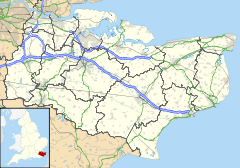Great Mongeham
| Great Mongeham | |
|---|---|
 St Martin's Church, Great Mongeham |
|
| Great Mongeham shown within Kent | |
| Population | 762 {2011} |
| OS grid reference | TR347515 |
| District | |
| Shire county | |
| Region | |
| Country | England |
| Sovereign state | United Kingdom |
| Post town | DEAL |
| Postcode district | CT14 |
| Dialling code | 01304 |
| Police | Kent |
| Fire | Kent |
| Ambulance | South East Coast |
| EU Parliament | South East England |
| UK Parliament | |
Great Mongeham is a village and civil parish in east Kent, on the outskirts of Deal. Its name is derived from Mundelingham or village of Mundel. Parts of Great Mongeham's church, St Martin's, date back to the 13th century. In the 19th century it was restored by William Butterfield.
Locally produced ice cream and sausages found favour with Queen Elizabeth The Queen Mother, who, as Lord Warden of the Cinque Ports, often stayed in her nearby official residence, Walmer Castle.
Significant figures who have lived in the village include Stephen Haggett, Proctor of Queens' College, Cambridge in the seventeenth century and Olivia Barclay, astrologer.
Great Mongeham may have been a settlement as long ago as the Bronze Age. When the site for the new primary school was being dug in February 1949 the body of a man and two fragments of food vessels were found. The man was in the crouched burial position used in the Bronze Age and one of the fragments was dated to about 1000 BC.
Great Mongeham is close to the Roman road which ran from Dover to Richborough Castle. Archaeologists have discovered Roman pottery and evidence of cremation but we do not know if there was a permanent settlement here at that time.
There certainly was a settlement here in 761 AD. In that year King Eadbert of Kent gave some land to St Augustine's Abbey in Canterbury. This included the village, which was then called Mundelingeham. The names means "settlement of Mundel's people". By 1195 it was written as Munigeham. A possible variation may be Monyngham, seen in 1399. It had become Mongeham by 1610.
...
Wikipedia

